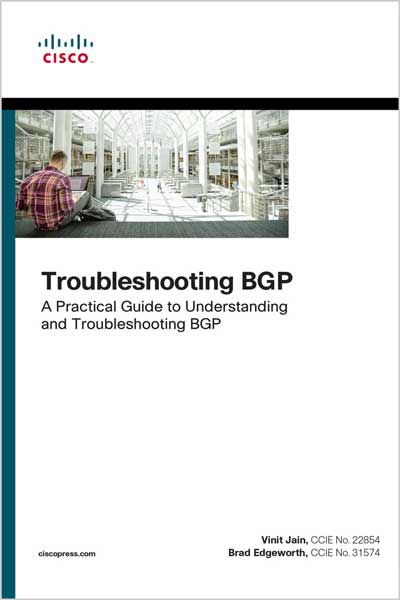Building Reliable Networks with the Border Gateway ProtocolIljitsch van Beijnum

#BGP
#Network
#Protocol
#Border_Gateway_Protocol
#routing
#DDoS
#router
Border Gateway Protocol (BGP) is the routing protocol used to exchange routing information across the Internet.
It makes it possible for ISPs to connect to each other and for end-users to connect to more than one ISP. BGP is the only protocol that is designed to deal with a network of the Internet's size, and the only protocol that can deal well with having multiple connections to unrelated routing domains.This book is a guide to all aspects of BGP: the protocol, its configuration and operation in an Internet environment, and how to troubleshooting it. The book also describes how to secure BGP, and how BGP can be used as a tool in combating Distributed Denial of Service (DDoS) attacks. Although the examples throughout this book are for Cisco routers, the techniques discussed can be applied to any BGP-capable router.The topics include:
- Requesting an AS number and IP addresses
- Route filtering by remote ISPs and how to avoid this
- Configuring the initial BGP setup
- Balancing the available incoming or outgoing traffic over the available connections
- Securing and troubleshooting BGP
- BGP in larger networks: interaction with internal routing protocols, scalability issues
- BGP in Internet Service Provider networks
The book is filled with numerous configuration examples with more complex case studies at the end of the book to strengthen your understanding. BGP is for anyone interested in creating reliable connectivity to the Internet.
Table of Contents
- The Internet, Routing, and BGP
- IP Addressing and the BGP Protocol
- Physical Design Considerations
- IP Address Space and AS Numbers
- Getting Started with BGP
- Traffic Engineering
- Security and Integrity of the Network
- Day-to-Day Operation of the Network
- When Things Start to Go Down: Troubleshooting
- BGP in Larger Networks
- Providing Transit Services
- Interconnecting with Other Networks
- Cisco Configuration Basics
- Binary Logic, Netmasks, and Prefixes
- Notes on the IPv4 Address Space
Reviews
Border Gateway Protocol (BGP) governs the exchange of routing information among autonomous networks, ensuring that packets can get from point A to point B regardless of most possible problems. BGP explores the capabilities and limitations of this exquisitely important protocol with an eye to teaching network engineers how to build systems that are faster, less costly, and more survivable than ever before. It's a great guide for those responsible for managing the interfaces between large networks and their neighbors, and a valuable aid for people preparing for their Cisco Certified Network Professional (CCNP) tests or other advanced certifications.
Authors of protocol-centric books risk becoming bogged down in bits. Iljitsch van Beijnum avoids overwhelming his readers with packet diagrams and message analysis, choosing instead to focus on how routers use BGP to efficiently use available connections (he focuses on Cisco Systems routers in his configuration examples, but the concepts apply universally). He also pays attention--and these sections are among the book's best--to strategies for coping with problems such as cable cuts and Distributed Denial of Service (DDoS) attacks. He understands, and conveys to his readers through network diagrams, configuration listings, and diagnostic traces, that BGP is a tool for managing the points at which networks intersect. --David Wall
Topics covered: Border Gateway Protocol (BGP), particularly as configured under Cisco Internetwork Operating System (IOS), and its means of describing routes across independently managed networks. Sections deal with addressing, bandwidth provisioning, traffic engineering, system monitoring, selecting and interconnecting with Internet Service Providers (ISPs), and troubleshooting.
About the Author
Iljitsch van Beijnum has been working with BGP in ISP and end-user networks since 1996. He has configured the protocol on single-router networks; networks with several hundred Ciscos ranging from the slowest to the fastest available; and multivendor environments with BGP running on Cisco and Juniper routers, Extreme switches, and FreeBSD hosts running GNU Zebra




